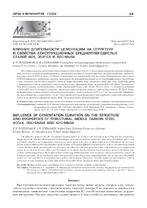| dc.contributor.author | Поздняков, Е. П. | |
| dc.contributor.author | Степанкин, И. Н. | |
| dc.coverage.spatial | Минск | ru |
| dc.date.accessioned | 2024-04-11T13:06:36Z | |
| dc.date.available | 2024-04-11T13:06:36Z | |
| dc.date.issued | 2024 | |
| dc.identifier.citation | Поздняков, Е. П. Влияние длительности цементации на структуру и свойства конструкционных среднеуглеродистых сталей 40Х, 35ХГСА и 42CrMoS4 = Influence of cementation duration on the structure and properties of structural middle carbon steel 40Cr4 35CrMnSi4 and 42CrMoS4 / Е. П. Поздняков, И. Н. Степанкин // Литье и металлургия. – 2024. – № 1. – С. 69-77. | ru |
| dc.identifier.uri | https://rep.bntu.by/handle/data/141820 | |
| dc.description.abstract | Исследовано влияние увеличения длительности цементации с 8 до 12 ч с последующей закалкой и низкотемпературным отпуском на структурообразование и контактную усталость конструкционных среднеуглеродистых низколегированных сталей 35ХГСА, 40Х и 42CrMoS4, не относящихся к традиционно цементуемым. Подтверждено, что в стали 35ХГСА повышенное содержание кремния увеличивает микротвердость поверхности термодиффузионно-упрочненных слоев, снижает количество углерода и толщину заэвтектоидной зоны, уменьшает объемную долю карбидной фазы и размеры включений по сравнению с аналогичными слоями, сформированными на сталях 40Х и 42CrMoS4. Установлено, что максимальную износостойкость имеют термоупрочненные слои стали 35ХГСА после 12‑часовой цементации и стали 40Х после 8‑часовой цементации, микроструктура которых состоит из мартенсита отпуска, 10–15 об. % кар‑ бидов размером не более 10 мкм и остаточного аустенита – 10 об. % в стали 35ХГСА и 17 об. % в стали 40Х. Обнаружено, что содержание углерода более 1,8 мас. % на поверхности цементованных слоев приводит к снижению износостойкости из-за высокого содержания (более 30 об. %) крупных (более 10 мкм) карбидов. | ru |
| dc.language.iso | ru | ru |
| dc.publisher | БНТУ | ru |
| dc.title | Влияние длительности цементации на структуру и свойства конструкционных среднеуглеродистых сталей 40Х, 35ХГСА и 42CrMoS4 | ru |
| dc.title.alternative | Influence of cementation duration on the structure and properties of structural middle carbon steel 40Cr4 35CrMnSi4 and 42CrMoS4 | ru |
| dc.type | Article | ru |
| dc.identifier.doi | 10.21122/1683-6065-2024-1-69-77 | |
| local.description.annotation | The influence of increasing the cementation duration from 8 to 12 hours with subsequent quenching and low-temperature tempering on the structure formation and contact fatigue of structural medium-carbon low-alloy steels 35CrMnSi4, 40Cr4, and 42CrMoS4, which are not traditionally cemented, was investigated. It has been confirmed that in steel 35CrMnSi4, the increased silicon content enhances the microhardness of the surface of thermally diffused-hardened layers, reduces the amount of carbon and the thickness of the proeutectoid zone, decreases the volumetric fraction of carbide phase and inclusion sizes compared to similar layers formed on steels 40Cr4 and 42CrMoS4. It was found that the thermally hardened layers of steel 35CrMnSi4 after 12‑hour carburizing and steel 40Cr4 after 8‑hour carburizing exhibit maximum wear resistance. Their microstructure consists of tempered martensite, 10–15 vol. % of carbides with a size of less than 10 μm, and retained austenite – 10 vol. % in steel 35CrMnSi4 and 17 vol. % in steel 40Cr4. It was found that a carbon content of more than 1.8 wt. % on the surface of cemented layers leads to a decrease in wear resistance due to the high content (more than 30 vol. %) of large (more than 10 μm) carbides. | ru |

